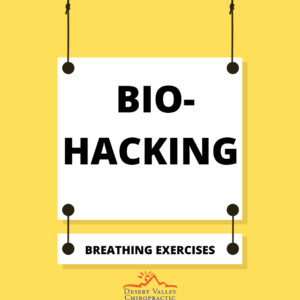
Hack Your Way to Better Health
We are on our fourth biohack of the year, Just Breath! Biohacking Your Breathing. So far we have discussed the concept of biohacking itself, the importance of knowing your vitamin D levels and maintaining them, chiropractic care and how it relates to increased health and vitality and this month we will discuss breathing exercises and learning to control our breathing for improved health. My goal as your chiropractor is to bring to our patients at Desert Valley Chiropractic and our North Phoenix community simple inexpensive ways to improve their health and feel a sense of empowerment over their healthcare journey.
Learn to Control Your Breath
Learning to control your breathing is a very important biohack that can help with everything from increased lung capacity, leading to better exercise capacity and longevity, to controlling pain and anxiety. Did you know that even your lungs need exercise to stay healthy and for your body to function normally? Your body needs oxygen for survival. Every activity in the body is dependent on oxygen, including the metabolic functioning of cells. The lungs perform the task of delivering oxygen to every part of the body. By practicing a few exercises regularly, you can train your lungs to increase their capacity, which will help you inhale more oxygen. This will, in turn, protect the body from various breathing disorders, help increase stamina, and ensure every part of the body gets adequate oxygen. Breathing is not just a necessity of life—it also has an array of positive effects on our body, mind, and spirit.

When we breathe deeply and mindfully, our breath can create profound physiological effects that we’re only beginning to appreciate with the rise of yoga, meditation, and other breathwork practices in the last few decades. Chiropractic care compliments yoga and mediation practices as we also focus on alignment and balance. Your chiropractic adjustments assist in healthy breathing by reducing tension and inflammation allowing the vertebra in your mid back to align, your ribs and the muscles in your neck to all work together to assist in better breathing.
So, scroll down and check out these super-efficient exercises to increase your lung capacity.
Breathing Exercises
These exercises are not meant to diagnosis or treat any other condition If you are not feeling well please seek medical attention. Also if you have an existing lung condition get clearance from your lung doctor (pulmonologist) before you begin these.
Better Breathing Tip: It’s normal to hold your shoulders tense and high. Before starting any breathing technique, take a minute to drop your shoulders down, close your eyes, inhale, exhale and relax.
Number One is Belly Breathing
Inhale through the nose push your belly out.
This is the exact opposite movement of sucking it in! Now breath out through the mouth and pull your stomach in while pushing your breath out.
To do belly breathing:
- Place one hand on your abdomen. Place one hand on your upper chest.
- Focus your breathing on your abdomen.
- As you breathe in, the hand on your abdomen should rise.
- As you breathe out, the hand on your abdomen should lower.
- Breathe in through the nose. Breathe out slowly through pursed lips.
- Start by doing it while lying on your back. Then try it while sitting. Then try it while standing. Finally, try it while doing an activity.
Learning to belly breath is the foundation for good breathing practice.

Number Two is Pursed Lips Breathing
Pursed lip breathing helps control shortness of breath , and provides a quick and easy way to slow your breathing. This helps to manage stress, anxiety and pain. During a panic attack, taking rapid breaths can lead to a faster heart rate, dizziness, muscle tension, and other symptoms. These symptoms may, in turn, contribute to even more anxiety.
This should feel like smelling flowers and blowing out candles.
To do pursed lips breathing:
- Breathe in through your nose (as if you are smelling something) for about 2 seconds.
- Pucker your lips like you’re getting ready to blow out candles on a birthday cake.
- Breathe out very slowly through pursed-lips, two times longer than you breathed in.
- Work towards increasing your times
- 2 seconds in : 4 seconds out
- 4 seconds in : 8 seconds out
- 8 seconds in : 16 seconds out
Number 3 is 4-7-8 breathing
The 4-7-8 breathing technique requires a person to focus on taking a long, deep breath in and out. Rhythmic breathing is a core part of many meditation and yoga practices as it promotes relaxation.
Dr. Weil is a celebrity doctor and the founder and director of the University of Arizona Center for Integrative Medicine.
Dr. Andrew Weil teaches the 4-7-8 breathing technique, which he believes can help with the following:
- reducing anxiety
- helping a person get to sleep
- managing cravings
- controlling or reducing anger responses

To try the 4-7-8 method, begin by sitting with your back straight. Once you are familiar with these steps, the exercise can be performed while lying in bed, too. You’ll want to:
- Place the tip of your tongue against the ridge of tissue behind your upper front teeth. You’ll keep it there for the entire exercise.
- Completely exhale through your mouth, making a “whoosh” sound.
- Close your mouth and inhale quietly through your nose as you mentally count to four.
- Hold your breath for a count of seven.
- Exhale completely through your mouth, making another “whoosh” sound to a count of eight.
Number 4 is Alternate nostril breathing
Alternate nostril breathing is a simple technique originating from Ayurvedic medicine and yoga that is designed to settle the mind, body, and emotions:
- Lift your right hand up toward your nose, exhale completely and then use your right thumb to close your right nostril.
- Inhale through your left nostril and then close the left nostril with your fingers.
- Then release your thumb from the right nostril and exhale through this side.
- Next, inhale through the right nostril and then close it again with your thumb.
- Release your left nostril and exhale though it.
- Repeat for as long as required and finish with an exhalation on the left side.
Many people feel they do not need to increase their lung capacity until the time a simple and short exercise like playing with their kids or running with pets tires them and leaves them breathless.
Do these exercises to increase lung capacity and enjoy leisure time with loved ones without experiencing shortness of breath and fatigue
https://www.lung.org/lung-health-diseases/wellness/breathing-exercises




